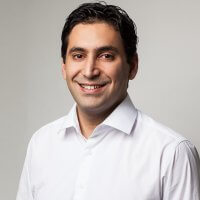Dry AMD: What forms of therapy are there?
Age-related macular degeneration – or AMD for short – is divided into two forms and manifestations: dry AMD and wet AMD.
Injection therapy for wet AMD
The wet form of AMD can be treated with an injection therapy. In this, so-called growth factors (VEGF) are injected into the eye to inhibit the disease. The therapy is painless for the patient. Find out more about injection therapy for wet AMD.
No therapy for AMD
The dry form of AMD is currently not treatable with medication. The dry form of age-related macular degeneration usually occurs more frequently than the wet form. It is generally milder. Sufferers of dry AMD should visit the ophthalmologist regularly in order to have the course of the disease documented and to be able to immediately recognize and treat any wet form that can develop from a dry form.
Keeping regular check-ups for dry AMD
Affected persons will receive regular check-ups at the ophthalmologist acoording to the severity of the findings. The aim of the control is to monitor and log the course of dry AMD. The check-up appointments also give the opportunity to act immediately in the event of a wet AMD occurring and to initiate appropriate therapy to get the wet AMD dry again. Only a therapy of wet AMD can contain it and prevent impending blindness.
There is currently no proven form of therapy for dry AMD. The course of dry AMD must be closely monitored so that aggressive, wet AMD can be identified and treated at an early stage.
Measures for dry AMD
- At present, those affected can only try to have a positive effect on the dry form of AMD through their behavior. The only “therapy option” for patients is to ensure a balanced diet rich in vital substances and sufficient exercise.
- Certain constellations of findings and studies have shown that the regular intake of food supplements such as lutein, zeaxanthin, zinc, vitamin C and omega-3 fatty acids can have a positive effect.
- In addition, those affected should refrain from smoking, as this is a major risk factor for AMD.
- Alternative treatment options such as acupuncture, nanolaser of the macula or other probatory therapeutic approaches are not currently evidence-based and studies have not shown sufficient therapeutic effects.
- Therefore, alternative therapeutic approaches are currently also being rejected for nationwide patient treatment by professional associations such as the German Society of Ophthalmologists or the Professional Association of Ophthalmologists.




